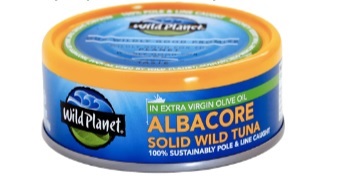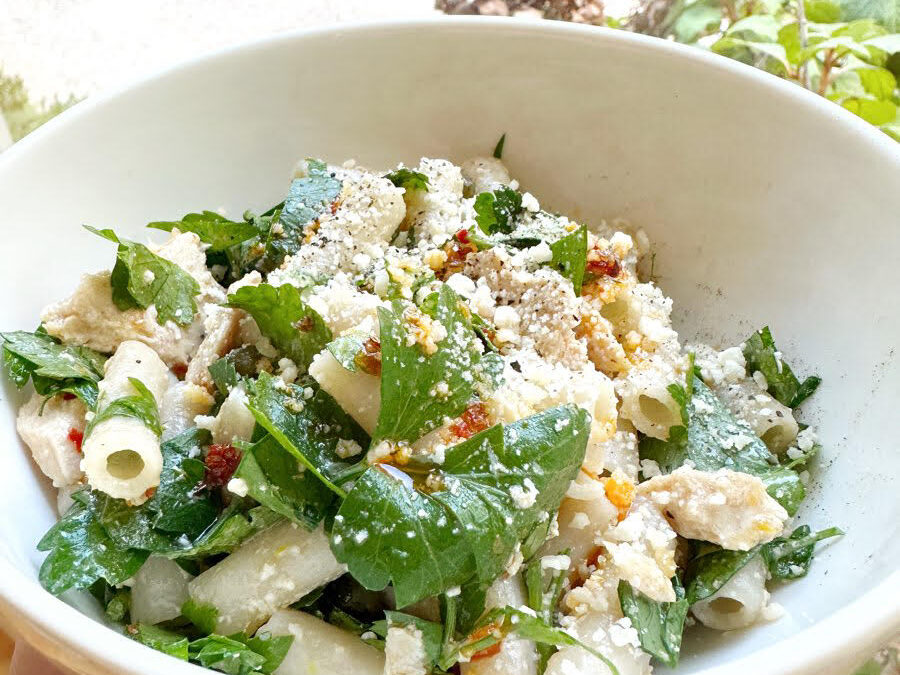Canned or tuna in a pouch is a high-protein, healthy fat ingredient to help you get dinner on the table in minutes! This pasta dish combines whole-wheat pasta with tuna and Mediterranean flavors from the lemon, parsley and capers. Confused about which form of canned tuna is best? Read on!
Tuna: Which Kind Do I Buy?
Just like many fish in the sea, there are many forms of tuna in your grocery aisle. For example:
What is the difference between light and white tuna?
The terms ‘light’ and ‘white’ tuna refer to the type of tuna. White tuna is albacore tuna. Light tuna is Yellowfin, Skipjack, or a mixture of both types. There are slightly different tastes and nutritional values between the two types . Oil packed tuna is going to take on the flavor of the oil while also being higher in calories and fat.
In terms of mercury content, you’ll get less mercury in light tuna. Fish acquire mercury in from the water they live and feed in. High amounts of mercury can be harmful to humans. The FDA recommends eating fish that may contain high amounts of mercury no more than 2-3 times a week. Pregnant people and children are at higher risk when consuming mercury, however staying within the FDA recommendations is alright for at-risk populations. If you are a frequent fish eater, choosing low mercury fish during the week will help minimize chances of illness from the mercury. Here’s the most important information: eat fish, eat fatty fish like salmon and tuna 2-3 times a week to reap the omega-3 benefits! But, if you eat tuna daily, are pregnant, or are a child, than it might be best to go with light, not white tuna.
Health Benefits
Tuna is rich in omega-3 fatty acids. Omega-3’s have been shown to support heart health and brain health. It has been shown that eating tuna twice a week has helped improve depression.
Tuna is also rich in potassium- a mineral that helps with lowering blood pressure. As you may know, tuna is high in protein and low in calories. Did you know that tuna is one of the protein-richest meats you can eat? Tuna offers about 20 g of protein in just 3 ounces. Protein is helpful in building muscles after a hard workout.
Oil vs. Water-Packed Tuna
What is the difference between oil-packed and water-packed tuna? Well, just as it sounds, oil-packed tuna is packaged with oil in it and may take some of the flavor from the oil. Water-packed tuna is packed with water in it. Oil-packed offers a richer flavor while providing healthy fat.
Sustainability
Marine Stewardship Council (MSC) certifies certain brands that meet sustainability criteria. This criterion includes the long-term health of the fish, well-managed stocks so the fish can be fished over a long period of time and takes into consideration the ecosystem of other species too. The MSC-certified brand has a blue logo on certified tuna packages/cans.

Ways To Use Tuna
Tuna is a versatile ingredient that could be turned into a burger or patty – check out our Lemon Tuna Cakes recipe here. Used traditionally, as a tuna salad made with mayo or Greek yogurt. Simply added to a pasta or salad dish to pump up the protein! We love it in this Mediterranean style tuna pasta with capers, lemon and parsley!


Tuna Pasta with Lemon & Parsley
Description
This pasta dish combines whole-wheat pasta with tuna and Mediterranean flavors from the lemon, parsley and capers.
Ingredients
- ½ Box of whole-wheat pasta (8 oz.)
- Wild Planet Albacore Solid Wild Tuna in Olive Oil
- 2 cloves of garlic
- ½–1 t. of chili flakes
- 2 T. of capers
- 1 bunch of fresh parsley, chopped (you can use less, but we like a lot!)
- 1 t. lemon zest
- 2 T. lemon juice
Instructions
- Cook the pasta according to the box minus one minute. It will finish cooking with the sauce. Save 1 cup of the pasta water for the sauce later.
- Pour the oil from the tuna in the same pot and heat on medium heat
- Sauté the garlic and chili flakes for about 1 minute
- Add the pasta, capers and 1/3 cup of pasta water together. The oil and pasta will thicken up in this step and cling to the pasta noodles.
- Turn off the heat and add your tuna, arugula, parsley, lemon zest and lemon juice. Toss gently so you will have chunks of tuna.
- Serve immediately

